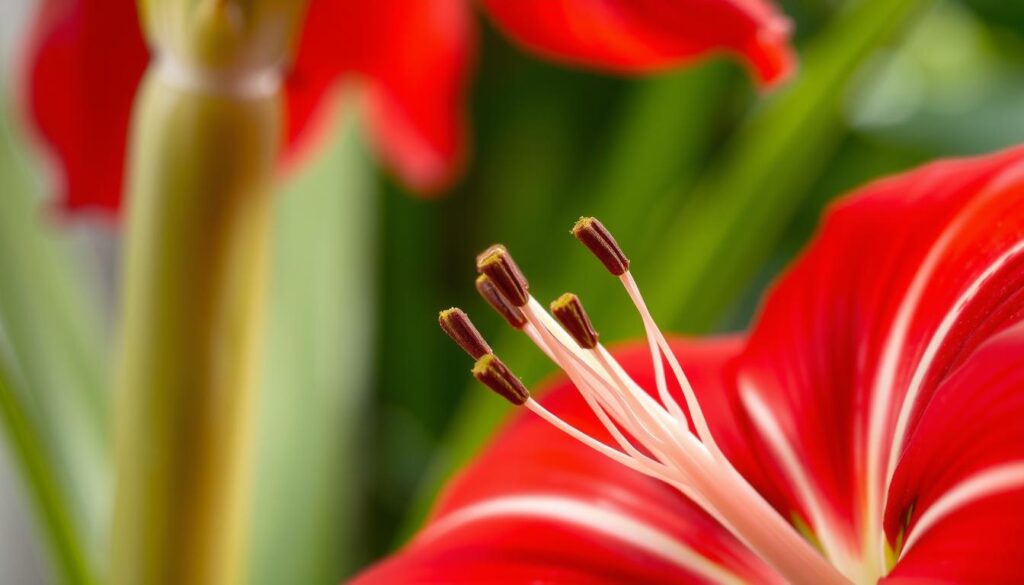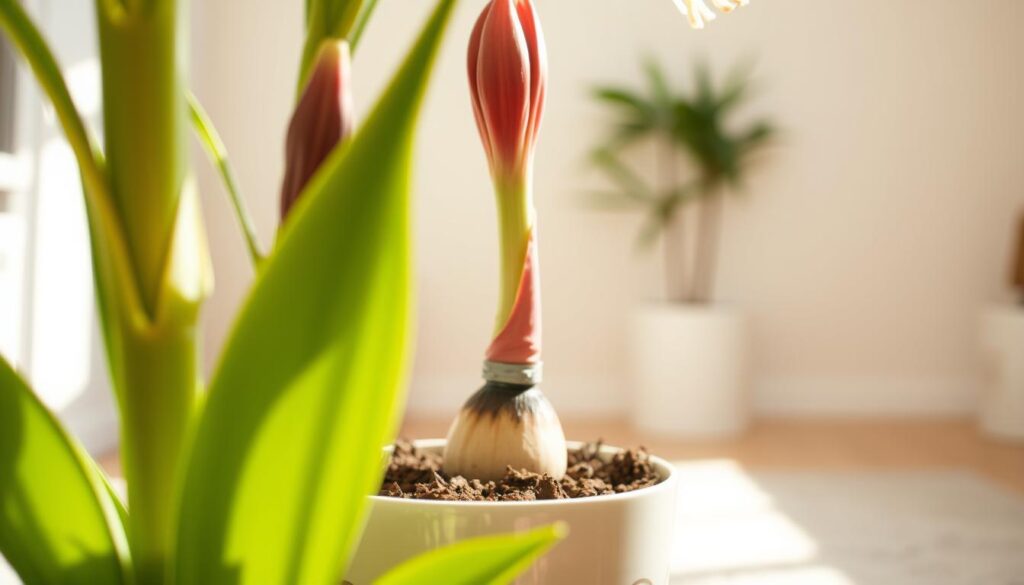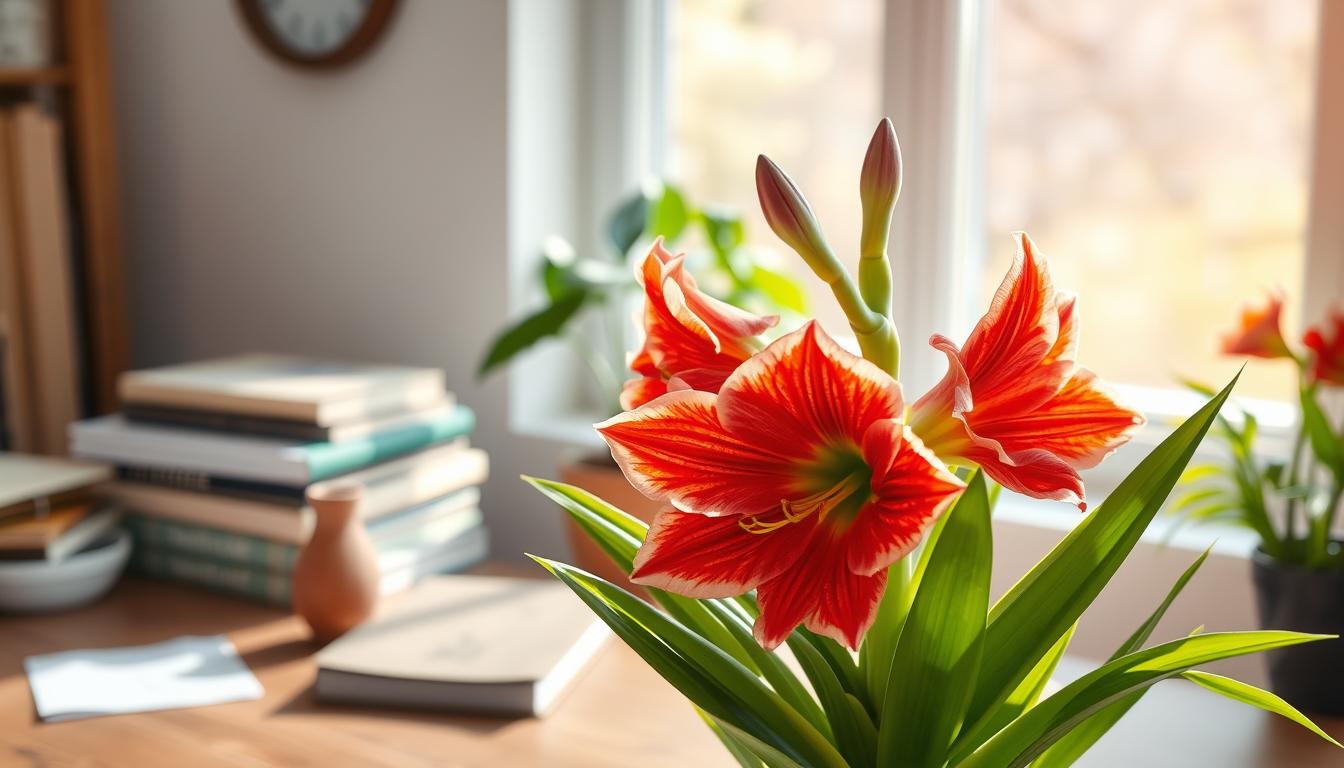Did you know that with proper care instructions, an amaryllis bulb can bloom multiple times?
After the vibrant flowers have faded, it’s key to give your amaryllis the right maintenance. This ensures it lives long and blooms again.
By following simple care tips, you can keep your amaryllis healthy and thriving. This makes your indoor garden beautiful and gives you blooms every year.
Key Takeaways
- Understand the importance of post-bloom care for amaryllis plants.
- Learn simple tips to maintain your amaryllis after blooming.
- Discover how to encourage future blooms.
- Find out how to keep your amaryllis healthy and thriving.
Understanding Your Amaryllis Plant
Knowing how your amaryllis plant grows is key to caring for it after it blooms. These plants have big, beautiful flowers. But they also need care during growth, blooming, and rest.
The Natural Life Cycle of Amaryllis Bulbs
Amaryllis bulbs grow, bloom, and then rest. After blooming, they focus on getting ready for next year. It’s important to care for them right to see more blooms.
The bulb uses its leaves to make energy. This energy is stored for next year’s blooms.
What Happens After the Flowers Fade
When the flowers go away, your amaryllis needs special care. You need to change how you water and feed it. This helps the leaves grow and store energy.
Some important indoor amaryllis care tips are letting the leaves grow and keeping a steady temperature. By caring for your amaryllis right, you can see beautiful flowers every year.
Amaryllis Care Indoors After Blooming: The Essentials

The post-bloom phase is very important for your amaryllis. Proper care can help it bloom again. You need to follow a few key steps.
First Steps After the Last Bloom
After the flowers fade, remove the flower stalk. This stops the plant from making seeds. Cut the stalk about an inch above the bulb.
Be careful not to hurt the bulb or leaves. This is key for the plant to grow and store energy for next time.
Creating the Ideal Indoor Environment
To keep your amaryllis healthy, you need the right indoor conditions. This includes the right light and temperature.
Light Requirements
Put your amaryllis in a bright, sunny spot. But, avoid direct sunlight to prevent leaf burn. East- or west-facing windows are best for the right light without burning the leaves.
Keep the temperature between 65°F to 75°F (18°C to 24°C). Don’t put the plant near heating or cooling vents, fireplaces, or drafty windows. Sudden temperature changes can stress the plant.
By following these tips, you can make a great environment for your amaryllis to thrive after blooming.
Cutting Back the Flower Stalk
When your amaryllis flowers wilt, it’s time to cut the stalk. This helps your plant grow again. It’s important for caring for indoor amaryllis flowers.
When to Remove Spent Flower Stalks
Wait until the flowers fade and the stalk starts to dry. This means the blooming is done. Cutting too soon can harm the plant. So, be patient in nurturing indoor amaryllis post-bloom.
Proper Cutting Techniques to Avoid Damage
Use a sharp knife or shears to cut the stalk close to the bulb. Cut just above where the stalk meets the bulb. This keeps the bulb safe and helps it grow well.
Foliage Care During the Growth Phase
When your amaryllis plant grows, taking care of its leaves is key. Leaves help the bulb get ready for new flowers. This is important for future blooms.
Why Healthy Leaves Are Crucial for Future Blooms
Healthy leaves are very important for your amaryllis plant. They help the bulb get the nutrients it needs. This is how your plant can bloom again in the future.
Make sure your plant gets lots of sunlight. But, it should not be too direct. This helps the leaves stay healthy.
Maintaining Vibrant Foliage Year-Round
To keep your amaryllis leaves looking good, you need to take care of them. This means watering them right, giving them food, and trimming them when needed. Also, watch out for bugs or sickness and fix it if you see any.
By doing these things, your amaryllis will have beautiful leaves. These leaves will help your plant make more flowers for a long time.
Watering Regimen for Post-Bloom Amaryllis
The time after the flowers fall off is very important for your amaryllis. It needs the right amount of water to grow and bloom again. Keep giving your amaryllis water to help it grow.
Adjusting Watering Frequency Throughout the Year
Your amaryllis needs water in different ways at different times. When it’s growing a lot, like after it blooms, it needs more water. When it’s not growing as much, like in winter, it needs less water.
Recognizing and Fixing Water-Related Issues
Too much or too little water can hurt your amaryllis. Knowing the signs of each helps you water it right.
Signs of Overwatering
- Yellowing leaves
- Soft, mushy bulb
- Presence of mold or mildew
Signs of Underwatering
- Wilted or dry leaves
- Slow growth
- Premature dormancy
| Watering Issue | Symptoms | Solution |
|---|---|---|
| Overwatering | Yellowing leaves, soft bulb | Reduce watering frequency, improve drainage |
| Underwatering | Wilted leaves, slow growth | Increase watering frequency, ensure soil moisture |
Change how often you water your amaryllis based on its needs. Watch for signs of too much or too little water. This way, your amaryllis will stay healthy and bloom well.
Fertilizing Your Amaryllis After Flowering

After your amaryllis finishes blooming, it needs nutrients to bloom again. Fertilizing it is key to its care. It helps the bulb get ready for the next bloom.
Selecting the Optimal Fertilizer for Bulb Strength
Choosing the right fertilizer is very important. Look for a balanced, water-soluble fertilizer like 20-20-20. This formula has equal nitrogen, phosphorus, and potassium for plant health. Avoid fertilizers with too much nitrogen because they make weak leaves instead of strong bulbs.
Seasonal Fertilizing Schedule for Maximum Results
Follow a seasonal schedule for best fertilizing results. Start fertilizing once a month after blooming. Keep going until the leaves turn yellow and die back naturally. This usually happens in late summer or early fall. Then, fertilize every 6-8 weeks. This schedule helps your amaryllis grow strong and bloom well.
The Dormancy Period: When and How
After the flowers fade, your amaryllis needs a special time called dormancy. This is when it gets ready to bloom again. Knowing when and how to start dormancy is key for post-blooming care for amaryllis.
Recognizing When Your Plant Needs Rest
Your amaryllis will tell you it’s time for rest by turning yellow and dying. This means it’s ready for its sleep. Let it do this naturally, as forcing it can harm the bulb.
Step-by-Step Guide to Inducing Dormancy
Start by watering less as the leaves turn yellow. Stop watering when the leaves are gone. This tells the bulb it’s time to sleep. Good care during this time helps it grow strong for next year’s blooms.
Proper Bulb Storage During the Resting Phase
When the leaves are gone, dig up the bulb. Clean it softly and let it air dry. Then, put it in a cool, dark spot in a breathable bag.
Temperature Requirements
Keep the bulb in a spot between 40°F to 50°F (4°C to 10°C). Don’t let it get too cold, as it can hurt the bulb.
Humidity Considerations
Keep the humidity low to stop rot. A cool, dry place is best for your amaryllis bulb during sleep, helping with nurturing indoor amaryllis post-bloom.
By following these steps, you give your amaryllis the care it needs to rest well. This prepares it for amaryllis bulb care post-blooming and beautiful blooms next time.
Repotting Your Amaryllis for Continued Health
Repotting is key to keeping your Amaryllis healthy and beautiful. As it grows, its pot might get too small. Knowing when and how to repot is vital for its health and blooms.
When Repotting Is Necessary for Your Amaryllis
Repotting is needed when the bulb grows too big for its pot. Or if the bulb is almost filling the pot or roots are coming out. Amaryllis plants usually need a new pot every 3 to 4 years. If blooms are fewer or soil dries fast, it’s time to repot.
Complete Repotting Process with Soil Recommendations
Start by picking a pot just a bit bigger than the old one. Amaryllis likes to be a little root-bound. Choose a potting mix made for bulbs that drains well.
Take the bulb out of its pot carefully to avoid harming the roots. Check the bulb and cut off any dead or rotting roots. Put the bulb in the new pot, making sure the base is in the soil but the neck and leaves are above.
Propagating Your Amaryllis
Propagating Amaryllis is easy. You can do it by dividing bulbs or growing from seeds. This way, you can share your plants with others. It’s important to take good care of your Amaryllis after it blooms.
Dividing Offset Bulbs Successfully
Dividing bulbs is a common way to grow more Amaryllis. Wait until your Amaryllis stops blooming and its leaves die back. Look for offsets around the main bulb.
Twist or cut the offsets from the main bulb. Make sure each has roots. Plant them in a potting mix that drains well. Water them a little until they start growing.
| Propagation Method | Time Required | Success Rate |
|---|---|---|
| Dividing Offset Bulbs | 1-3 months | High |
| Growing from Seeds | 3-5 years | Variable |
Growing New Plants from Seeds
Growing Amaryllis from seeds is slower. But it’s worth it. After the flowers fade, try to cross-pollinate them.
Once seeds are ready, plant them on the surface of a seed mix. Keep the soil moist and warm. Seedlings will come up in a few weeks. But, it takes years for them to bloom.
Also Read This- Top 10 Best Japanese Indoor Plant for fresh Air and Asthetic Look
Preparing Your Amaryllis for Reblooming
To make your amaryllis bloom again, you need to know its cycle. After it sleeps, it’s time to wake it up. Give it the right place to grow and bloom.
Waking the Bulb After Dormancy
When your amaryllis wakes up, check the bulb. Look for damage or rot. If it’s healthy, put it in a new pot with good soil.
Water it well after putting it in the pot. Put the pot in a bright, cool spot. But don’t put it in direct sunlight yet.
Techniques to Encourage Multiple Flower Stalks
To get more flowers, you need to adjust light and temperature.
Light Manipulation
Bright light helps amaryllis grow and bloom. When new growth shows, move it to a sunny spot. But keep it away from direct sunlight to avoid burning the leaves.
Temperature Control
The right temperature is key for blooms. Keep the pot in a spot with a steady temperature of 65°F to 75°F. Don’t put it near heaters, fireplaces, or drafty windows.
Troubleshooting Common Post-Bloom Problems
After your Amaryllis blooms, you might face some issues. These can include pests, diseases, or problems with growth and blooming. It’s important to take care of your plant to keep it healthy.
Identifying and Treating Pest Infestations
Pests like spider mites, mealybugs, and scale can harm your Amaryllis. Check your plant often and use insecticidal soap or neem oil to get rid of them. This helps stop big problems.
Preventing and Managing Fungal Diseases
Fungal diseases can come from too much water or humidity. Make sure your Amaryllis has good air flow and don’t water the leaves. If you see disease, cut off the bad parts and use a fungicide.
Resolving Growth and Blooming Issues
If your Amaryllis isn’t growing or blooming right, it might need more light or water. Follow amaryllis care instructions for watering and feeding. Changing these things can fix growth and blooming problems.
By fixing these common issues, your Amaryllis will stay healthy and bloom well. Remember, “Proper care after blooming is key for Amaryllis health and blooms.”
“The key to successful Amaryllis care lies in understanding and responding to the plant’s needs after it finishes blooming.”
Conclusion
Proper care after your amaryllis blooms is key for its health and future flowers. Follow the steps in this article to keep your amaryllis thriving indoors.
After the flowers drop, cut off the stalk to help the plant grow again. Keep watering the same and feed it often to keep it healthy. This will help the bulb get ready for next year’s flowers.
When it’s time for the plant to rest, water it less. Repotting every few years is also important. This keeps the soil fresh and the bulb happy. Following these tips will make your amaryllis bloom brightly every year.
Learning and using these easy care steps will make your amaryllis a lasting part of your home. With the right care, you’ll see its beautiful flowers every year.
FAQ
How do I care for my amaryllis after it finishes blooming?
After your amaryllis stops blooming, cut off the flower stalk. This helps the plant grow again. Keep the leaves bright and watered well.
What is the ideal environment for an amaryllis after blooming?
Your amaryllis likes bright, indirect light and warm temperatures. Keep it between 65-75°F (18-24°C). Don’t put it in direct sunlight or very cold places.
How often should I water my amaryllis after it blooms?
Water your amaryllis a little after it blooms. Let the soil dry a bit before watering again. When it starts growing, water more often but not too much.
How do I propagate my amaryllis?
You can grow new amaryllis plants by dividing bulbs or seeds. But dividing is safer and more common.
Why is my amaryllis not blooming again?
If your amaryllis doesn’t bloom again, it might need more light, water, or food. Check how you care for it and make changes to help it bloom.
